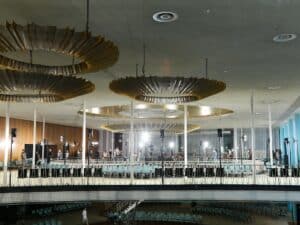In slow travel, there is perhaps an answer that can be part of a broader lesson. That in zooming in on life and taking ourselves out of the frame, the picture becomes all the richer.
This essay by Damien Cummings is taken from our current print issue on Life, which can be found in shops or purchased here
Inching around the bend in our cramped rental, a round of gasps interrupted what had thus far been an excruciatingly awkward journey. Flurries of excitable French, far beyond my high school level of comprehension, alerted me to the fact that while numbly scrolling on my smartphone, I had missed something of vital importance. “The waterfall,” one companion exclaimed, “It is flowing!”
Once a secret, Horsetail Falls in Yosemite National Park was known only to a dedicated few ramblers and photographers, but is now one of the social media wonders of the world. For a fleeting moment each year in February, the sun’s angle is such that for just over ten minutes each sunset, it is illuminated in hues of vibrant orange and crimson. A seasonal cascade of glittering lava some five hundred meters tall, they call it the firefall.
When I was there, it was little more than a trickle. My fellow travelers had gasped because it was not supposed to be there at all. In fact, it had not been for some years due to a string of unusually dry winters. But this year it flowed freely and, by far, the earliest it had done in some time. “It is a miracle,” declared my francophone hosts.
Seasonal warming due to climate change is the only reasonable answer as to why these waters now flow as they do. Nevertheless, visitor numbers continue to swell as thousands arrive by car each day to trundle their way across the congested valley floor in search of the miracle falls. This year, the problem became so severe that rangers closed two of the three most famous viewing points to the falls to dissuade tourists. The move was declared draconian by some and roundly praised by others who would rather usher in a new form of tourism. One that accommodates fewer people but does so with more room.
Slow travel is a phenomenon. It has been gaining in popularity among travel agents and tourists alike in the last decade as a response to the rapid advances of climate change in the era of low-cost flights. Take a shipping container from Rotterdam to French Guiana or pick your way through the Sri Lankan tea steppes on a steam train. Whatever floats your boat, there is a way to do it slowly.
On that day, I had been aiming for slow travel but ended up traveling slowly. I was packed into the back of a car with space for four, equipped for five, and including myself, containing six. The young French family that had taken pity on me as I stood at a bus stop, waiting in ignorance for a connection that would never come, had summarily thrown me in with three distinctly embarrassed, and not a little scared, teenagers of varying levels of moody resistance.
What had begun as a backlash against kerosene powered tourism became an obsession that would lead me from California to Buenos Aires by bus, train, boat, one horse and cart, and a few brief stints in the boot of a clapped out Bolivian taxi. Its allure was in its difficulty and its haphazard nature. In the people you met and the things you saw. The fact that you had to give up on the notion of going where you intended to go, and accept that you got where you ended up.



